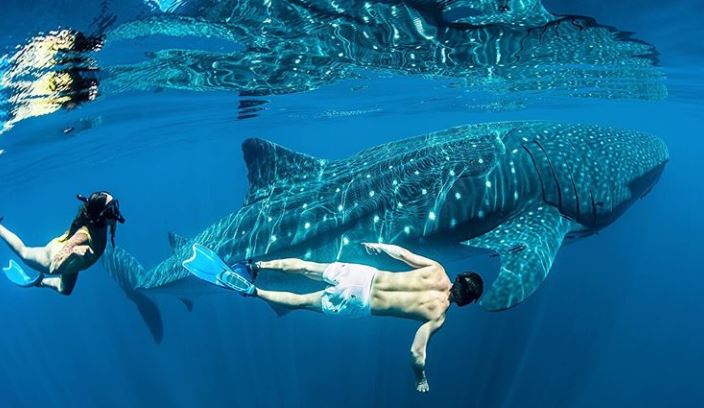The 700-mile-long body of water of the Sea of Cortez encompasses mainland Mexico and Baja California. This diverse sea is home to 900 varieties of fish and more than 2,000 species of marine invertebrates. This makes the Sea of Cortez one of the richest bodies of water on the face of the earth.
Gentle Giant of the Sea

Aside from the myriad of endemic marine creatures, the Sea of Cortez also attracts seasonal sea visitors like whale sharks. Acknowledged as the largest fish in the sea, whale sharks can grow up to 40 feet or more. These marine creatures can weigh as much as 20.6 tons. Just imagine a fish as big as a school bus! They are noted for their distinctive white dots throughout their bodies. These markings are like fingerprints because they are unique to each animal.
Despite their colossal mouths, whale sharks are perfectly harmless to humans. In fact, their diet is restricted to plankton, krill, copepods, fish eggs, and algae. These filter feeders open their humongous mouths to let the water come in and their bodies filter out food. They then release the water including any debris back into the ocean.
Fondly called the “gentle giants of the sea,” these creatures spend most of their lives traveling which makes them very lucky because they have no problems fulfilling their wanderlust. They are drawn to waters like the Sea of Cortez where they can have an all-you-can-eat buffet and gorge before continuing their voyage. These tropical waters serve not just a feeding ground but also as a nursery for their young.
International Whale Shark Day
On the 30th of August 2020, the world celebrated International Whale Shark Day. This meaningful day was established to raise awareness about the gentle giants of the sea and the vital role that they play in marine ecosystems. International Whale Shark Day also aims to encourage people around the world to protect and conserve this beautiful species.
If you want an opportunity to come up close and personal with these docile giants, get in touch with Baja Shark Experience to know more about our whale shark expeditions from October to April. Check also our swim with sharks cabo san lucas trips.
Whale shark encounter tips
Whale Sharks are considered endangered species and they deserve nothing short but respect and care. So before taking a plunge to snorkel with the planet’s biggest fish, here are some tips to have a fun, safe and worry-free adventure.
Pay attention to your guide
Begin by paying attention to the instructions of your guide and follow them accordingly. These rules are meant to protect both wildlife and tourists so take them very seriously.
Use reef-friendly products
Avoid wearing sunscreen, tanning lotion, deodorant, scents, and oils on the day of snorkeling because they may contain chemicals that are harmful to the gentle giants of the sea. If you want to apply sun-protection products, use reef-friendly ones.
Enter the water slowly and quietly
When you reach the location, enter the water slowly and quietly as possible to minimize splashing. Too much noise and commotion can spook the docile beasts. Besides, the last thing you want to happen is to drive the majestic creatures away by your lack of finesse.
Keep your hands to yourself
Keep in mind that you are a mere visitor in someone else’s territory so respect these amazing creatures when you venture into their turf. Snorkeling with the whale sharks gives you a chance to see them up close but it doesn’t mean that you can touch them whenever you please. You’re not in a petting zoo. You can only look but do not touch! Direct interaction can push the animal to leave the area and spoil your encounter. The best thing to do is to observe them quietly from a safe distance of at least three meters away from the head and four meters from the tail. This way you can be a quiet spectator and allow them to have ample space to do their natural business.
Did you know that humans could transmit diseases to the whale sharks that could cause an infection? This is another reason why snorkelers are strongly advised to stay at a good distance to protect them from contaminating diseases.
Do not litter
As a guest, it’s only fitting that you honor the home of these majestic animals by keeping the waters clean and not removing anything from the ocean. If someone visits your house, you wouldn’t like it if they leave garbage behind and take your things. Think of this scenario when you venture into the ocean as a gentle reminder to yourself.
Maintain proper approach
The manner of approaching the biggest fish in the ocean is very important too. The proper way of doing this is by moving towards it from the side or swimming alongside near its pectoral fins. Do not panic if you see it swimming towards your group; simply divide into two sections to give it space to swim in between.
No flash photography
It’s alright to take photos but avoid flash photography to prevent frightening or disorienting the docile giant. Fish generally have no eyelids so the sudden flash can increase the glare and temporarily blind them. You can avoid giving whale sharks undue stress by not using your flash, regardless if someone is watching or not.
Snorkeling with these amazing animals will give you a new appreciation for whale sharks and hopefully inspire you to contribute to their conservation.
